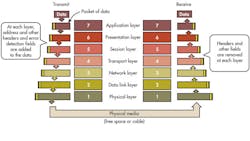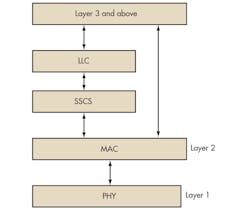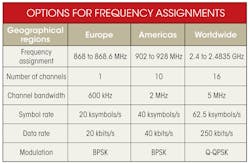What’s The Difference Between IEEE 802.15.4 And ZigBee Wireless?
Download this article in .PDF format
There are many standards for short-range wireless technologies, but this variety often perplexes designers who want to select a standard for an application. The popular IEEE 802.15.4 standard and its relative ZigBee often are confused. They aren’t the same thing.
Table Of Contents
• Short-Range Wireless Choices
• ZigBee
Short-Range Wireless Choices
A designer of wireless applications has multiple choices of standards and protocols ranging from the simple to the amazingly complex. The most familiar choices are Bluetooth and Wi-Fi. Bluetooth has found a niche in the audio space with billions of cell-phone headset connections, automotive hands-free connections, and wireless speakers. Its newer low-energy versions are finding many applications in the medical and sports/fitness world to monitor an individual’s physical status.
Wi-Fi is the premier local-area network (LAN) technology for high-speed Internet access for laptops, smart phones, and tablets. New faster versions are used in smart TV sets for video transfer. In a stripped down form, it can also be used in data acquisition applications. Low-power versions are now available. Many versions and supplement use the 2.4-, 5-, and 60-GHz industrial, scientific, and medical (ISM) bands.
The proprietary Z-Wave standard has found a niche in the home monitoring and control market. There are other proprietary standards for specific applications, such as WirelessHD for 60-GHz video transfer. Many of these proprietary variations use the ISM bands below 1 GHz, including garage door openers at 315 MHz, remote temperature monitors at 433 MHz, and data acquisition at 915 MHz. A growing category is cellular connectivity for machine-to-machine (M2M) and Internet of Things (IoT) applications.
Most of the rest of the standards use some variation of the 802.15.4 standard.
IEEE 802.15.4
The Institute of Electrical and Electronics Engineers (IEEE) supports many working groups to develop and maintain wireless and wired communications standards. For example, 802.3 is wired Ethernet and 802.11 is for wireless LANs (WLANs), also known as Wi-Fi. The 802.15 group of standards specifies a variety of wireless personal area networks (WPANs) for different applications. For instance, 802.15.1 is Bluetooth, 802.15.3 is a high-data-rate category for ultra-wideband (UWB) technologies, and 802.15.6 is for body area networks (BAN). There are several others.
The 802.15.4 category is probably the largest standard for low-data-rate WPANs. It has many subcategories. The 802.15.4 category was developed for low-data-rate monitor and control applications and extended-life low-power-consumption uses. The basic standard with the most recent updates and enhancements is 802.15.4a/b, with 802.15.4c for China, 802.15.4d for Japan, 802.15.4e for industrial applications, 802.15.4f for active (battery powered) radio-frequency identification (RFID) uses, and 802.15.4g for smart utility networks (SUNs) for monitoring the Smart Grid. All of these special versions use the same base radio technology and protocol as defined in 802.15.4a/b.
The 802.15.4 standard defines the physical layer (PHY) and media access control (MAC) layer of the Open Systems Interconnection (OSI) model of network operation (Fig. 1). The PHY defines frequency, power, modulation, and other wireless conditions of the link. The MAC defines the format of the data handling. The remaining layers define other measures for handing the data and related protocol enhancements including the final application.
1. Most networking systems, both wired and wireless, use the OSI communications model. Most systems also use at least the first four layers, but many do not use all seven layers.
More specifically, Figure 2 shows the layer 1 and layer 2 details of 802.15.4.
2. The 802.15.4 standard uses only the first two layers plus the logical link control (LLC) and service specific convergence sub-layer (SSCS) additions to communicate with all upper layers as defined by additional standards.
The goal of the standard is to provide a base format to which other protocols and features could be added by way of the upper layers (layers 3 through 7). While three frequency assignments are available, the 2.4-GHz band is by far the most widely used (see the table). Most available chips and modules use this popular ISM band.
The standard uses direct sequence spread spectrum (DSSS) modulation. It is highly tolerant of noise and interference and offers coding gain to improve link reliability. Standard binary phase-shift keying (BPSK) is used in the two low-speed versions, while offset-quadrature phase-shift keying (O-QPSK) is used for the higher-data-rate version. O-QPSK has a constant wave envelope meaning that more efficient non-linear power amplification techniques can be used to minimize power consumption.
With regard to channel access, 802.15.4 uses carrier sense multiple access with collision avoidance (CSMA-CA). This multiplexing approach lets multiple users or nodes access the same channel at different times without interference. Most transmissions are short packets that occur infrequently for a very low duty cycle (<1 %), minimizing power consumption. The minimum power level defined is –3 dBm or 0.5 mW. Most modules use 0 dBm or 1 mW. However, some 20-dBm or 100-mW modules are available.
Transmission range varies considerably depending on the nature of the path that must for the most part be line of sight (LOS). Transmit power level and receiver sensitivity are also factors. Under the best conditions the range can be as great as 1000 meters with a clear outdoor path. Most applications cover a shorter range of 10 to 75 meters.
With regard to networking capability, 802.15.4 defines two topologies. One of them is a basic star (Fig. 3a). All communications between nodes must pass through the central coordinator node. A basic peer-to-peer (P2P) topology is also defined (Fig. 3b). Any device may then talk to any other device. This basic topology may be expanded into other topologies in the upper network layers, such as the popular mesh topology.
3. The 802.15.4 standard defines the star (a) and peer-to-peer (b) common network topologies.
ZigBee
The most widely deployed enhancement to the 802.15.4 standard is ZigBee, which is a standard of the ZigBee Alliance. The organization maintains, supports, and develops more sophisticated protocols for advanced applications. It uses layers 3 and 4 to define additional communications features (Fig. 4). These enhancements include authentication with valid nodes, encryption for security, and a data routing and forwarding capability that enables mesh networking. The most popular use of ZigBee is wireless sensor networks using the mesh topology.
4. The ZigBee protocol is defined by layer 3 and above. It works with the 802.15.4 layers 1 and 2.
The main benefit of the mesh topology is that any node can communicate with any other node, if not directly if within range, but indirectly by relaying the transmission through multiple additional nodes (Fig. 5). The network then can spread out over a larger area. Furthermore, it increases network reliability as it still functions even if one node is disabled. There are usually alternate paths through the network to sustain a connection. For example, if node A wishes to communicate with node G, it can relay data through nodes C and E. If node C fails, another path is via nodes B, D, and F. ZigBee mesh networks are self-configuring and self-healing.
5. In a mesh network, each node communicates with its closest neighbor as conditions permit. Note that there are alternate paths between any two nodes.
ZigBee is also available in a version that supports energy harvesting where no battery or ac mains power is available. And, one of the key benefits of ZigBee is the availability of pre-developed applications. These upper-layer software additions implement specialized uses for ZigBee. Some of these applications include:
• Building automation for commercial monitoring and control of facilities
• Remote control (RF4CE or RF for consumer electronics)
• Smart energy for home energy monitoring
• Health care for medical and fitness monitoring
• Home automation for control of smart homes
• Input devices for keyboards, mice, touch pads, wands, etc.
• Light Link for control of LED lighting
• Retail services for shopping related uses
• Telecom services
• Network services related to large mesh networks
The ZigBee Alliance also offers full testing and certification of ZigBee-enabled products to ensure interoperability.
ZigBee has been around for more than 10 years now and is widely used. It is a great option for many applications. For some simpler communications projects it may be overkill with its extra complexity and cost. Plain old 802.15.4 may be a better choice in such cases.
Other Variations
While ZigBee is the most notable example of the use of the base 802.15.4 standard, other protocols are defined for specific applications. The 802.15.5 standard defines a mesh networking capability for 802.15.4. WirelessHART is a radio version of the wired HART (highway addressable remote transducer) protocol standard widely used in automation and industrial control applications. It defines a time multiplexed protocol for accessing multiple nodes of sensors and actuators.
The International Society of Automation’s ISA100.11a industrial control standard is used in process control applications. It adds channel hopping, variable time-slot multiplex options, and mesh networking to the 802.15.4 base.
One other interesting variation is 6LoWPAN, created by the Internet Engineering Task Force (IETF) (RFC 5933 and RFC 4919). This protocol adaption allows 802.15.4 radios to carry 128-bit addresses of version 6 of the Internet Protocol (IPv6). It uses header compression and address translation techniques so 802.15.4 devices can access the Internet. The IPv6 packets are compressed and encapsulated so they fit into standard 802.15.4 packet frames. This variation facilitates the use of the standard to implement IoT, Smart Grid, and M2M applications.
References
IEEE: www.ieee802.org/15/pub/TG4.htmland www.standards.ieee.org/about/get/802/802.15html
International Society of Automation: www.isa.org/isa100
Internet Engineering Task Force: www.ietf.org
WirelessHART: www.hartcomm.org
ZigBee Alliance: www.zigbee.org
About the Author

Lou Frenzel
Technical Contributing Editor
Lou Frenzel is a Contributing Technology Editor for Electronic Design Magazine where he writes articles and the blog Communique and other online material on the wireless, networking, and communications sectors. Lou interviews executives and engineers, attends conferences, and researches multiple areas. Lou has been writing in some capacity for ED since 2000.
Lou has 25+ years experience in the electronics industry as an engineer and manager. He has held VP level positions with Heathkit, McGraw Hill, and has 9 years of college teaching experience. Lou holds a bachelor’s degree from the University of Houston and a master’s degree from the University of Maryland. He is author of 28 books on computer and electronic subjects and lives in Bulverde, TX with his wife Joan. His website is www.loufrenzel.com.






